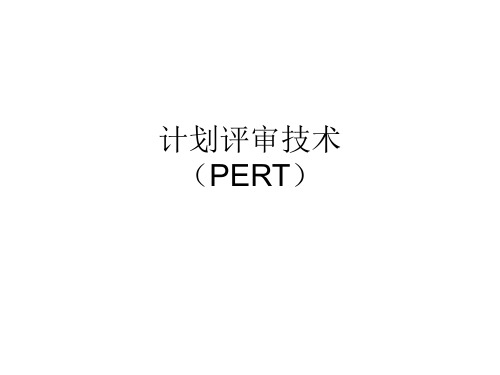PERT计划评审技术
- 格式:pptx
- 大小:345.22 KB
- 文档页数:54





计划评审技术的案例下面就给你来个计划评审技术(PERT)的案例。
就说咱们要办一场超级酷炫的户外音乐节吧。
这事儿可复杂了,就像搭一个超级大的乐高城堡一样。
一、确定活动的各个任务和估计时间。
1. 邀请乐队。
这是个大事儿。
我们得先找那些超火的乐队,还得看他们的档期。
乐观估计呢,如果一切顺利,我们有个音乐圈的好朋友帮忙牵线,可能10天就能搞定5个超棒的乐队签约。
这就像是走了大运,乐队们都排着队等我们邀请呢。
但是呢,正常情况下,得一家一家谈,可能要花20天。
毕竟乐队的经纪人也得考虑各种因素,什么演出费啊,舞台安排之类的。
悲观估计就惨了,如果遇到一些乐队临时变卦或者有其他突发情况,比如说主唱生病了或者有别的大活动冲突了,那可能得30天才能搞定邀请。
2. 场地租赁和布置。
乐观估计,如果我们找到一个现成的超合适的户外场地,而且场地老板特别好说话,15天就能租下来并且把基础的布置,像舞台框架搭建、观众区划分这些搞定。
就好像这个场地一直在等着我们去办音乐节似的。
正常来说,要25天。
得办理各种租赁手续,还要找工人来搭建,还可能遇到天气不好不能施工的情况。
悲观估计呢,要是场地突然出了什么问题,比如被政府临时征用了一部分,那我们就得重新找场地,这可能就得40天了。
3. 宣传推广。
乐观估计,如果我们有个超级厉害的营销团队,一下子就抓住了大众的眼球,利用各种社交媒体、线下海报等方式,12天就能让这个音乐节的消息传遍整个城市,大家都抢着买票。
正常情况下,20天才能达到比较好的宣传效果。
毕竟要设计宣传海报、制作宣传视频、联系媒体这些事儿。
悲观估计,如果宣传过程中遇到什么负面新闻,比如说被竞争对手抹黑,或者宣传渠道突然出了问题,那可能得30天才能把宣传做到位。
二、计算每个任务的期望时间。
按照计划评审技术的公式,期望时间=(乐观时间 + 4×正常时间+悲观时间)÷6。
1. 对于邀请乐队:期望时间=(10 + 4×20+30)÷6=(10 + 80 + 30)÷6 = 120÷6 = 20天。

PERT法计划评审技术(Program Evaluation and Review Technique,PERT):对单个活动无法进行确定估算时,就其乐观、悲观和最可能的估算进行加权平均的一种估算技术基于最可能获得的资源、最可能取得的资源生产率、对资源可用时间的现实预计、资源对其他参与者的可能依赖以及可能发生的各种干扰等,所得到的活动持续时间基于活动的最好情况,所得到的活动持续时间基于活动的最差情况,所得到的活动持续时间最可能时间最乐观时间最悲观时间期望值估算T e = O + 4M + P6假设要求活动所需要的时间的概率分布可以使用β分布Te 为时间期望值;O为最乐观时间;M为最可能时间;P为最悲观时间标准差估算δte = P -O6δte为(单个活动)期望时间的标准差标准差活动工期落在标准差范围内的概率(te+/-nδ,n=1,2,3)保证率工期在0 到te+ nδ的概率1个标准差68.3%84.1%2个标准差95.5%97.7%3个标准差99.7%99.86%概率值保证率✓工期或成本,假设在某个节点上的完工保证率是起点到该节点的面积✓相应的失败率为空白区域的面积路径汇聚三个活动相互独立,完成每个活动的概率均为85%,使用路径汇聚,到达B的概率为85%×85%×85%=61.4%✓在制定进度计划的工具与技术“进度网络分析”中提到路径汇聚B68%C95%D99.73%A54%一个活动的历时估算如下:最乐观估算=6天;最可能估算=21天;最悲观估算=36天;那么,该活动在16天到26天的时间完成的几率有多高BB 按照95%的置信度,项目历时应为613至641天C按照99%的置信度,项目历时应为585至669天D按照68%的置信度,项目历时应为547至603天A按照95%的置信度,项目历时定为547至603天项目历时估算的预期值是627天,而最可能的历时估算为575天,标准差为14天,下面哪一种陈述是正确的C正态分布的峰值是期望值而不是可能值B低于50%C正好等于50%D高于50%A在一个管道项目的概念阶段,工程师进行了如下估算:材料成本最可能为100,000 美元,最乐观为90,000美元,最悲观为120,000美元。
计划评审技术pert的案例英文回答:Program Evaluation and Review Technique (PERT)。
PERT (Program Evaluation and Review Technique) is a project management tool used to plan, schedule, and track project activities. It involves identifying the tasks to be completed, their sequence, and their interdependencies. PERT also estimates the time and resources required foreach task, and calculates the critical path the sequence of tasks that determines the overall project duration.PERT uses a network diagram to represent the project's tasks and their relationships. The diagram includes nodes (representing tasks) and arrows (representing dependencies). The time required for each task is estimated as aprobability distribution, with a most likely time,optimistic time, and pessimistic time.The critical path is the longest path through the network diagram, and it determines the minimum time required to complete the project. Identifying the critical path helps project managers focus on the tasks that are most likely to delay the project, and to allocate resources accordingly.PERT is a valuable tool for project managers as it helps them:Plan and schedule projects effectively.Identify the critical path and potential bottlenecks.Estimate project duration and resource requirements.Monitor project progress and identify areas for improvement.中文回答:计划评审技术(PERT)。
计划评审技术(PERT)求工期、标准差、方差以及概率 计划评审技术(PERT) o PERT 使用3种估算值来界定活动持续时间的近似区间:最可能时间(Tm) 0基于最可能获得的资源、最可能収得的资源生产率、对资源可用时间的 现实预计、资源对其他参与者的可能依赖以及可能发生的各种干扰等,所得到的活动持续时 间。
最乐观时间(To) o 基于活动的最好情况,所得到的活动持续时间。
最悲观时间(Tp) o 基于活动的最差情况,所得到的活动持续时间。
PERT 分析方法对以上3种估算进行加权平均,来计算:预期活动持续时间(Te):95.46% 99.73% 图:正态统计分布图」根据正态统计分布图,预期活动持续时间(Te)表示50%概率的可能性在该工期完成。
工期 落在预期活动持续时I'可1个标准差的范围之I'可的概率是68. 26%,落在2个标准差的范围Z 间的概率是95. 46%,在3个标准差的范I 韦IZ 间的概率是99. 73%。
例1:公司的某项目即将开始,项目经理估计该项目10天即可完成,如果出现问题耽搁了 也不会超过20天完成,最快6天即可完成。
根据项FI 历时估计中的三点估算法,你认为该 项目的历时为(37)该项目历时的估算标准差为(38) o6 -2 36 ■ Jan6c e 2 M 8 6 26 35(37) A. 10 天 B. 11 天 C. 12 天 D. 13 天(38) A. 2. 1 天氏 2. 2 天 C. 2. 3 天 D. 2. 4 天解答:(37)B'1=(6+4x10+20)/6=11(38) C。
二(20-6)/6二2. 3例2: A任务持续时间悲观估计为36天,最大可能估计为21天,乐观估计为6天。
那么A 行为在16到26天之间完成的概率有多大?A. 55. 70%B. 68. 26%C. 95. 46%D. 99. 73%解答:(1)求出o 。
计划评审技术pert的案例英文回答:Pert (Program Evaluation and Review Technique) is a project management tool used to schedule, organize and coordinate tasks within a project. It is particularly useful for projects that involve a high degree of uncertainty and complexity.One case where Pert was used effectively was in the construction of a new office building. The project involved multiple tasks such as site preparation, foundation laying, structural construction, interior finishing, and landscaping. Due to the complexity of the project and the interdependencies among tasks, Pert was chosen to create a detailed schedule and identify critical paths.The first step in using Pert for this project was to identify all the tasks that needed to be completed. This involved consulting with various stakeholders includingarchitects, engineers, contractors, and suppliers. Each task was then broken down into smaller sub-tasks to create a comprehensive list of activities.Next, the estimated time required for each task was determined. This involved consulting with experts in each field to gather accurate data on the time required for completion. This step was crucial for identifying the critical path, which is the sequence of tasks that determines the total duration of the project.Once all the tasks and their estimated durations were identified, a Pert chart was created to visualize the project schedule. The chart consisted of nodes representing tasks and arrows representing the sequence in which the tasks needed to be completed. This allowed the project team to clearly see the critical path and identify any potential bottlenecks or delays.Throughout the project, the Pert chart was regularly updated to reflect the actual progress of tasks. This allowed the project team to monitor the project's progress,identify any deviations from the original schedule, and make necessary adjustments to keep the project on track.Overall, the use of Pert in this case was instrumentalin ensuring the successful completion of the officebuilding construction project. It provided a clear and detailed schedule, identified critical paths, and allowedfor effective monitoring and control of the project's progress.中文回答:Pert(项目评估和审查技术)是一种项目管理工具,用于安排、组织和协调项目中的任务。